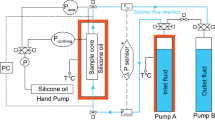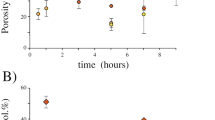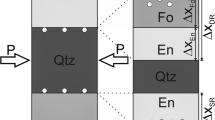Abstract
The reaction kinetics and fluid expulsion during the decarbonation reaction of calcite+quartz=wollastonite+CO2 in water-absent conditions were experimentally investigated using a Paterson-type gas apparatus. Starting materials consisted of synthetic calcite/quartz rock powders with variable fractions of quartz (10, 20, and 30 wt%) and grain sizes of 10 µm (calcite) and 10 and 30 µm (quartz). Prior to reaction, samples were HIPed at 700 °C and 300 MPa confining pressure and varying pore pressures. Initial porosity was low at 2.7–6.3%, depending on pore pressure during HIP and the amount and grain size of quartz particles. Samples were annealed at reaction temperatures of 900 and 950 °C at 150 and 300 MPa confining pressures, well within the wollastonite stability field. Run durations were between 10 min and 20 h. SEM micrographs of quenched samples show growth of wollastonite rims on quartz grains and CO2-filled pores between rims and calcite grains and along calcite grain boundaries. Measured widths of wollastonite rims vs. time indicate a parabolic growth law. The reaction is diffusion-controlled and reaction progress and CO2 production are continuous. Porosity increases rapidly at initial stages of the reaction and attains about 10–12% after a few hours. Permeability at high reaction temperatures is below the detection limit of 10−21 m2 and not affected by increased porosity. This makes persistent pore connectivity improbable, in agreement with observed fluid inclusion trails in form of unconnected pores in SEM micrographs. Release of CO2 from the sample was measured in a downstream reservoir. The most striking observation is that fluid release is not continuous but occurs episodic and in pulses. Ongoing continuous reaction produces increase in pore pressure, which is, once having attained a critical value (Pcrit), spontaneously released. Connectivity of the pore space is short-lived and transient. The resulting cycle includes pore pressure build-up, formation of a local crack network, pore pressure release and crack closure. Using existing models for plastic stretching and decrepitation of pores along with critical stress intensity factors for the calcite matrix and measured pore widths, it results that Pcrit is about 20 MPa. Patterns of fluid flow based on mineralogical and stable isotope evidence are commonly predicted using the simplifying assumption of a continuous and constant porosity and permeability during decarbonation of the rock. However, simple flow models, which assume constant pore pressure, constant fluid filled porosity, and constant permeability may not commonly apply. Properties are often transient and it is most likely that fluid flow in a specific reacting rock volume is a short-lived episodic process.







Similar content being viewed by others
References
Atkinson BK (1984) Subcritical crack growth in geological materials. J Geophys Res 89:4077–4114
Atkinson BK, Avdis V (1980) Fracture mechanics parameters of some rock-forming minerals determined using an indentation technique. Int J Rock Mech Min Sci Geomech Abstr 17:383–386
Baud P, Zhu W, Wong TF (2000) Failure mode and weakening effect of water on sandstone, J Geophys Res 105:16371–16389
Baumgartner LP, Valley JW (2001) Stable isotope transport and contact metamorphic fluid flow. In:Valley JW, Cole DR (eds) Stable isotope geochemistry (Reviews in Mineralogy and Geochemistry, vol 43) Mineral Soc Am, Washington, DC, pp 415–467
Bernabé Y, Brace WF, Evans B (1982) Permeability, porosity and pore geometry of hot-pressed calcite. Mech Mater 1:173–183
Brace WF, Paulding BW, Scholz C (1966) Dilatancy in the fracture of crystalline rocks. J Geophys Res 71:3939–3953
Buick IS, Cartwright I (2002) Fractured-controlled fluid flow and metasomatism in the contact aureole of the Marulan Batholith (New South Wales, Australia). Contrib Mineral Petrol 143:733–749
Churakov SV, Gottschalk, M (2003) Perturbation theory based equation of state for polar molecular fluids: II. Fluid mixtures. Geochim Cosmochim Acta 67:2415–2425
Connolly JAD (1997) Devolatilization-generated fluid pressure and deformation propagated fluid flow during prograde regional metamorphism. J Geophys Res 102:18149–18173
Connolly JAD, Holness MB, Rubie DC, Rushmer T (1997) Reaction-induced microcracking: an experimental investigation of a mechanism for enhancing anatectic melt extraction. Geology 25:591–594
Etheridge MA, Wall VJ, Vernon RH (1983) The role of the fluid phase during regional metamorphism and deformation. J Metamorph Geol 1:205–226
Etheridge MA, Wall VJ, Cox SF, Vernon RH (1984) High fluid pressures during regional metamorphism and deformation: Implications for mass transport and deformation mechanisms. J Geophys Res 89:4344–4358
Feenstra A, Wunder B (2002) Dehydration of diasporite to corundite in nature and experiment. Geology, 30:119–122
Ferry JM (1994) A historical review of metamorphic fluid flow. J Geophys Res 99:15487–15498
Ferry JM, Wing BA, Penniston-Dorland SC, Rumble DIII (2002) The direction of fluid flow during contact metamorphism of siliceous carbonate rocks: new data for the Monzoni and Predazzo aureoles, northern Italy, and a global review. Contrib Mineral Petrol 142:679–699
Fischer GJ (1992) The determination of permeability and storage capacity: Pore pressure oscillation method. In: Evans B, Wong TF (eds) Fault mechanics and transport properties of rocks. Academic Press, San Diego, pp 187–211
Fischer GJ, Paterson MS (1992) Measurement of permeability and storage capacity in rocks during deformation at high temperature and pressure. In: Evans B, Wong TF (eds) Fault mechanics and transport properties of rocks. Academic Press, San Diego, pp 213–252
Gilman JJ (1960) Direct measurements of the surface energies of crystals. J Appl Phys 31:2708–2718.
Gottschalk M (1997) Internally consistent thermodynamic data set for rock forming minerals in the system SiO2-TiO2-Al2O3-Fe2O3-CaO-MgO-FeO-K2O-Na2O-H2O-CO2: an alternative approach. Eur J Mineral 9: 175–223
Harker RI, Tuttle OF (1956) Experimental data on the PCO2–T curve for the reaction: calcite+quartz⇔wollastonite+carbon dioxide. Am J Sci 254:239–256
Heinrich W (1993) Fluid infiltration through metachert layers at the contact aureole of the Bufa del Diente intrusion, northeast Mexico: Evidence from stable isotopes. Contrib Mineral Petrol 119:362–376.
Heinrich W, Hoffbauer R, Hubberten HW (1995): Contrasting fluid flow patterns at the Bufa del Diente contact metamorphic aureole, north-east Mexico: evidence from stable isotopes. Contrib Mineral Petrol 119:362–376
Hickman SH, Evans B (1987) Influence of geometry upon crack healing rate in calcite. Phys Chem Miner 15:91–102
Jamtveit B, Bucher-Nurminen K, Stijfhoorn DE (1992) Contact metamorphism of layered shale-carbonate sequences in the Oslo rift. I. Buffering, infiltration, and the mechanisms of mass transport. J Petrol 33:377–422
Joesten R, Fisher G (1988) Kinetics of diffusion-controled mineral growth in the Christmas Mountains (Texas) contact aureole. Geol Soc Am Bull 100:714–732
Kirby SH, Engdahl ER, Denlinger R (1996) Intermediate-depth earthquakes and arc volcanism as physical expressions of crustal and uppermost mantle metamorphism in subducting slabs. In: Bebout GE, Scholl DW, Kirby SH, Platt JP (eds) Subduction, top to bottom. Geophys Monogr 96, pp 195–214
Ko Sc, Olgaard DL, Briegel U (1995) The transition from weakening to strengthening in dehydrating gypsum: Evolution of excess pore pressures. Geophys Res Lett 22:1009–1012
Ko Sc, Olgaard DL, Wong TF (1997) Generation and maintenance of pore pressure excess in a dehydrating system. 1. Experimental and microstructural observations. J Geophys Res 102:825–839
Labotka TC, Anovitz LM, Blencoe JG (2002) Pore pressure during metamorphism of carbonate rock: effect of volumetric properties of H2O-CO2 mixtures. Contrib Mineral Petrol 144:305–313
Lawn BR, Wilshaw TR (1975) Fracture of brittle solids. Cambridge University Press, New York, 204 pp
Miller SA, Nur A (2000) Permeability as a toggle switch in fluid-controlled crustal processes. Earth Planet Sci Lett 183:133–146
Milke R, Heinrich W (2002) Diffusion-controlled growth of wollastonite rims between quartz and calcite: comparison between nature and experiment. J. Metamorph Geol 20:467–480
Milsch H (2000) Experimentelle Untersuchung des Einflusses von Dekarbonatisierungs-reaktionen auf die Transporteigenschaften von Gesteinen. PhD Thesis, Faculty of Natural Sciences, University of Potsdam, Germany, 126 pp
Olgaard DL, FitzGerald JD (1993) Evolution of pore microstructures during healing of grain boundaries in synthetic calcite rocks. Contrib Mineral Petrol 115:138–154
Olgaard DL, Ko Sc, Wong TF (1995) Deformation and pore pressure in dehydrating gypsum under transiently drained conditions. Tectonophysics 245:237–248
Raleigh CB, Paterson MS (1965) Experimental deformation of serpentinite and its tectonic implications. J Geophys Res 70:3965–3985
Rummel F (1982) Fracture and flow of rocks and minerals. In: Landolt-Börnstein Group V: Geophysics 1B. Springer, Berlin Heidelberg New York, pp 141–239
Rutter EH, Brodie KH (1988) Experimental syntectonic dehydration of serpentinite under conditions of controlled pore water pressure. J Geophys Res 93:4907–4932
Rumble DIII, Ferry JM, Hoering TC, Boucot AJ (1982). Fluid flow during metamorphism at the Beaver Brook fossil locality, New Hampshire. Am J Sci 282:886–919
Santhanam AT, Gupta YP (1968) Cleavage surface energy of calcite. Int J Rock Mech Min Sci 5:253–259
Scholz CH, Sykes LR, Aggarwal YP (1973) Earthquake prediction: a physical basis. Science 181:803–810
Simpson G, Gueguen Y, Schneider F (2001) Permeability enhancement due to microcrack dilatancy in the damage regime. J Geophys Res 106:3999–4016
Tanner SB, Kerrick DM, Lasaga AC (1985) Experimental kinetic study of the reaction: calcite+quarz⇔wollastonite+carbon dioxide, from 1 to 3 kilobars and 500 to 850 °C. Am J Sci 285:577–620
Thompson AB (1997) Flow and focusing of metamorphic fluids. In: Jamtveit B, Yardley B (eds) Fluid flow and transport in rocks. Chapman and Hall, New York, pp 297–314
Urai JL, Feenstra A (2001): Weakening associated with the diaspore-corundum dehydration reaction in metabauxites: an example from Naxos (Greece). J Struct Geol 23:941–950
Walker AE, Rutter EH, Brodie K (1990) Experimental study of grain-size sensitive flow of synthetic, hot-pressed calcite rocks. In: Knipe RJ, Rutter EH (eds) Deformation, mechanisms, rheology and tectonics. Geol Soc Spec Publ, London, pp 259–284
Walther JV, Orville PM (1982) Volatile production and transport in regional metamorphism, Contrib Mineral Petrol 79:252–257
Wanamaker BJ, Evans B (1989) Experimental diffusional crack healing in olivine. In: Schock RN (ed) Point defects in minerals. Am Geophys Union, Geophys Monograph 31, pp 194–210
Wanamaker BJ, Wong TF, Evans B (1990) Decrepitation and crack healing of fluid inclusions in San Carlos olivine. J Geophys Res 95:15623–15641
White SH, Knipe RJ (1978) Transformation- and reaction-enhanced ductility in rocks. J Geol Soc Lond 135:513–516
Wilkinson DS, Ashby MF (1973) Pressure sintering by power-law creep. Acta Metall 23:1277–1285.
Wong TF, Ko Sc, Olgaard DL (1997) Generation and maintenance of pore pressure excess in a dehydrating system. 2. Theoretical analysis. J Geophys Res 102:841–852
Zhang S, Paterson MS, Cox SF (1994) Porosity and permeability evolution during hot isostatic pressing of calcite aggregates. J Geophys Res 99:15741–15760
Zhang S, FitzGerald JD, Cox SF (2000) Reaction-induced permeability during decarbonation of calcite+quartz→wollastonite+carbon dioxide. Geology 28:911–914
Zhang S, Paterson MS, Cox SF (2001) Microcrack growth and healing in deformed calcite aggregates. Tectonophysics 335:17–36
Acknowledgements
Harald Milsch acknowledges the financial support from the GeoForschungsZentrum whilst performing his Ph.D. Michael Naumann kept the gas medium apparatus running and Erik Rybacki is thanked for many constructive suggestions and discussions. SEM-microscopy was supported by Ursula Glenz. Harald Milsch appreciates his internship at MIT with Brian Evans and Gunter Siddiqi, which was co-financed by a NATO stipend. Thoughtful comments by R. Abart and B. Jamtveit are gratefully acknowledged.
Author information
Authors and Affiliations
Corresponding author
Additional information
Editorial responsibility: J. Hoefs
Rights and permissions
About this article
Cite this article
Milsch, H., Heinrich, W. & Dresen, G. Reaction-induced fluid flow in synthetic quartz-bearing marbles. Contrib Mineral Petrol 146, 286–296 (2003). https://doi.org/10.1007/s00410-003-0504-8
Received:
Accepted:
Published:
Issue Date:
DOI: https://doi.org/10.1007/s00410-003-0504-8




